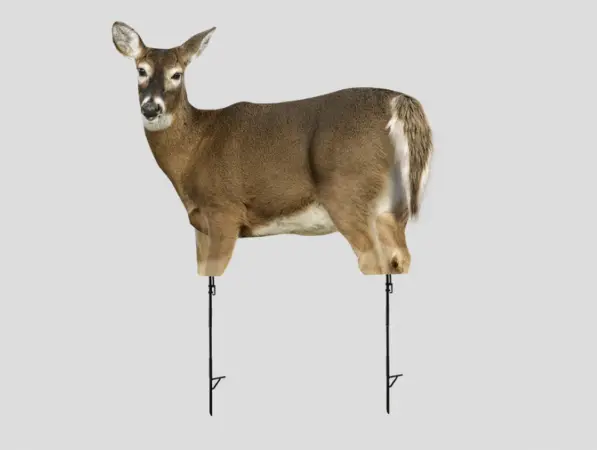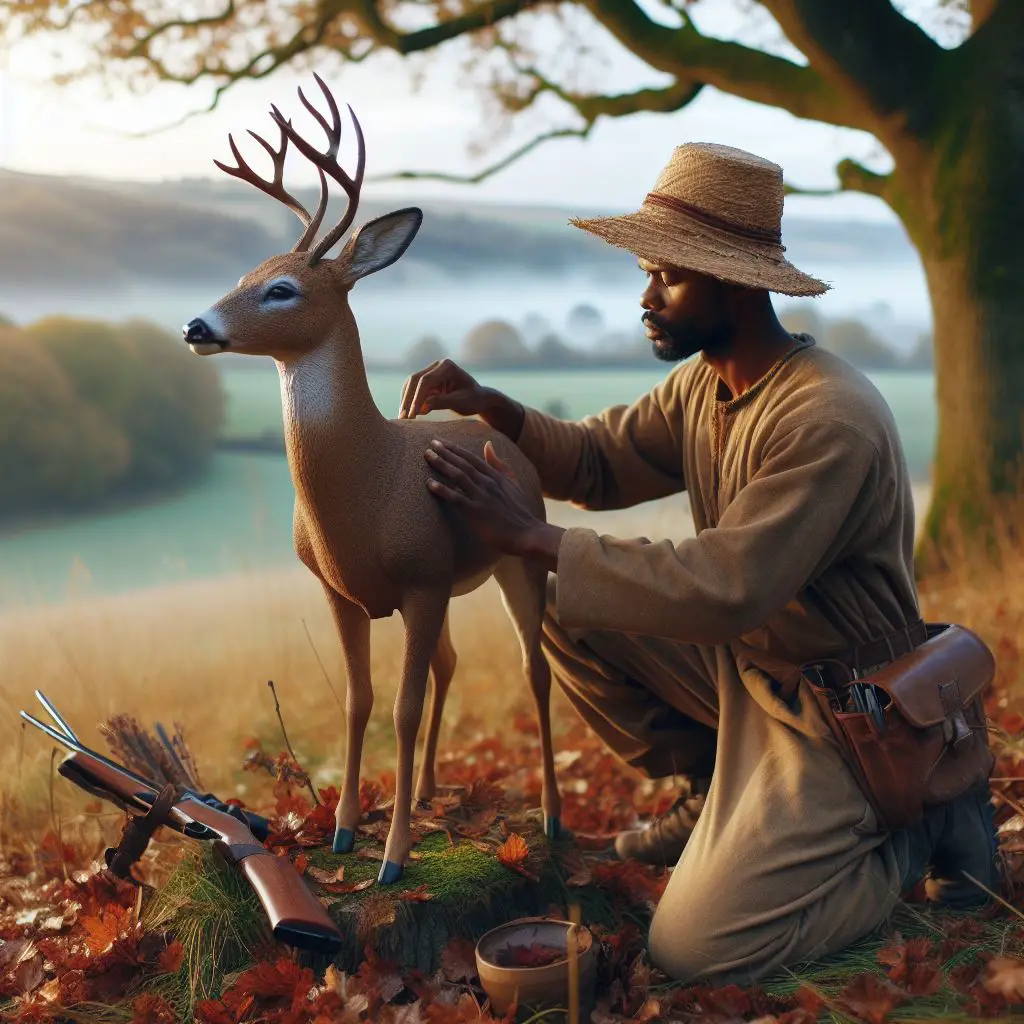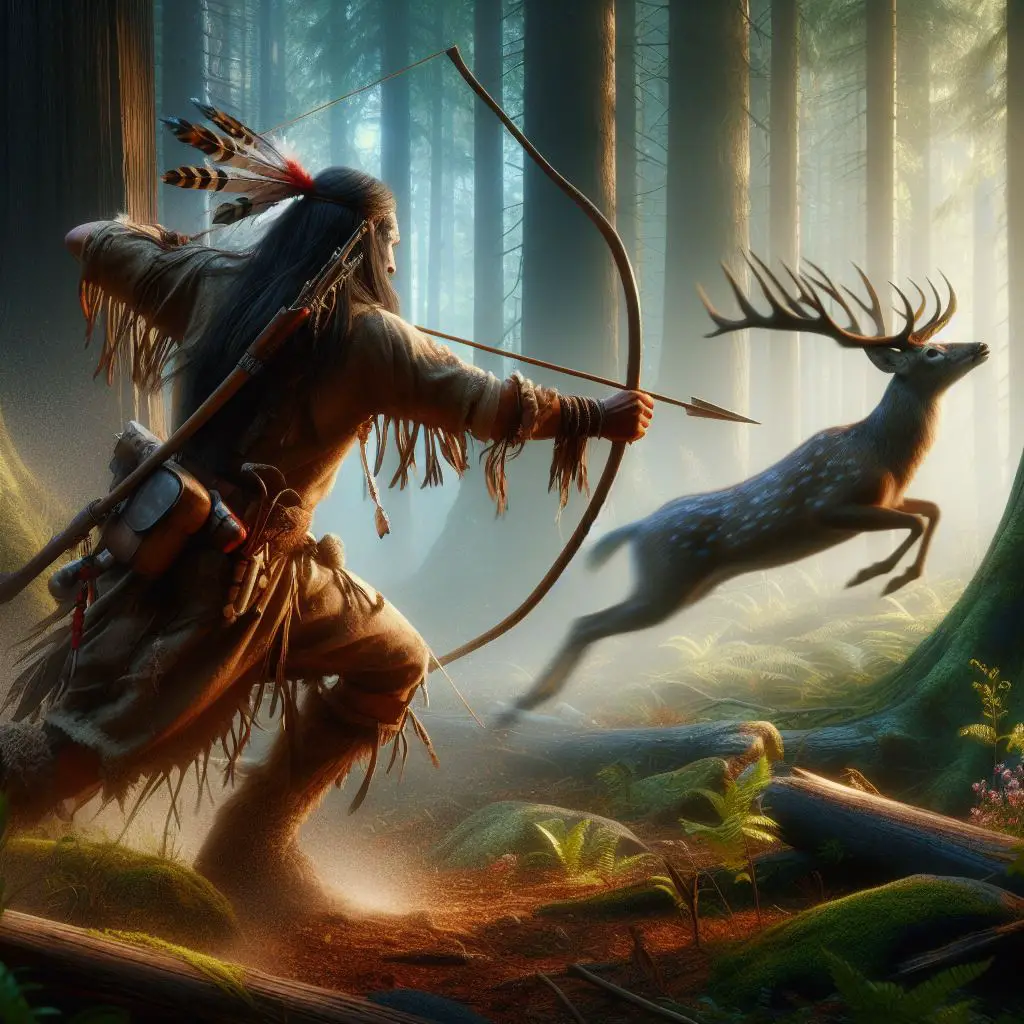Decoys are an effective tool for deer hunters, allowing you to draw in bucks by simulating other deer in the area. And using a doe decoy during rutting season can be particularly effective at pulling curious bucks within range.
In this comprehensive guide, we’ll cover everything you need to know about hunting deer over a doe decoy, including:
- How doe decoys work to attract bucks
- When to use a doe decoy during rutting season
- Best practices for setting up with doe decoys
- Doe decoy mistakes to avoid
- Recommended decoy models for hunting whitetail deer
- Strategies for using decoys for both archery and firearm hunting
- Tips from seasoned hunters on deploying doe decoys in the field
Whether new to decoy hunting or looking to take your existing setup to the next level, use this guide to gain the knowledge for decoying more bucks with confidence.
How Doe Decoys Attract Bucks During Rutting Season

Deer decoys are so effective because they tap into the natural breeding behaviors dominant during the rut. Early to late season, food and safety dominate activity driving deer movement.
But for a brief fall window, breeding becomes priority #1 for sexually mature bucks. And placing a simulated doe in their terrain is a direct challenge they instinctually cannot resist investigating up close.
Rutting Behaviors Activated by Doe Decoys
- Territorial response to competing buck suitors
- False estrus signals drawing breeding interest
- Dominance display opportunity to woo does
- Curiosity investigating newcomers in their area
Additionally, decoys add movement to an otherwise stationary hunter, further selling the realism of a live deer. Strategically used doe decoys grab the irresistible attention of testosterone-raged bucks.
Now let’s look at the optimal timing during rutting season for maximum decoy effectiveness.
When to Use Doe Decoys During the Rut
Decoy effectiveness fluctuates based on the exact stage of the rutting period in your hunting area:
| Phase | Rut Timing | Decoy Usage |
|---|---|---|
| Pre-Rut | Early Fall | Avoid decoys- food is still #1 priority |
| Peak Rut | Mid November | HIGHLY EFFECTIVE – sex drive maxed |
| Post Rut | Late November | Decent effectiveness as late breeders remain |
| Late Season | January onward | Avoid decoys – rutting over |
As you can see, doe decoy deployment is most productive during the peak rut weeks in November when sexually mature bucks are most active seeking does. But the early and late portions of rut can still see success as some bucks remain in breeding mode.
Outside mid-October through December however, bucks are less responsive to decoys, instead focused back on food sources and recovering strength. Be selective deploying doe decoys based on observed deer behaviors in your specific area.
Best Practices Setting Up With a Doe Decoy

Carefully planning out decoy placement is crucial for convincing arriving bucks your simulated doe is the real deal. Here are best practices:
Pick Strategic Location
Select secluded bedding/feeding zones bucks frequent rather than high traffic areas does avoid during peak rut. Bucks expect hot does in protected cover.
Consider Wind Factors
Make sure natural wind or thermal currents don’t give away your location. Approaching bucks rely heavily on nose and can blow your cover.
Use Realistic Postures
Stand or lay decoys rather than unnaturally fixed upright positions. Vary posture between setups.
Add Movement
Add a decoy motor, hanging decoy, or manually pull a rope to mimic natural motion. Avoid repeated patterns.
Use Scents
Spray scents like doe urine further sell realism to bucks relying on olfactory signals. Apply carefully given wind.
Conceal Yourself
Wear camo blending into surroundings, mask scents, and sit extremely still to avoid detection once bucks enter range.
With attention to factors buck key into like scent, sight and motion, an expertly deployed decoy can fool most dominant rutting bucks into thinking a hot doe awaits.
Doe Decoy Hunting Mistakes to Avoid
While using estrus doe decoys can call in emphatic rutting responses, make sure to avoid these common mistakes that can inadvertently spook incoming deer:
- Overusing Decoys – Continually setup in same exact spot/posture which can condition deer over time if they don’t encounter real estrus does
- Unrealistic Appearance – Cheap decoys with low detail levels, unconvincing posing, colors etc. can raise suspicion for sharp-sensed bucks
- Poor Concealment – Failing to blend adequately into surroundings allows bucks to prematurely spot you and retreat before ideal range
- Ignoring the Wind – Given how heavily buck rely on nose, getting busted because of poor wind/thermals ruins decoy hunts fast
- Excessive Calling – Overcalling on rattlers or grunt tubes screams desperation unlikely from real estrus does and risks spooking trophy bucks smarter than average
Prevent these missteps with attentive deer behavior study, patience and learning over each decoy season until you master presenting irresistible simulated does.
Now that we’ve covered best practices, common pitfalls and optimal timing, let’s switch gears into evaluating the top decoy models available to hunters…
Recommended Doe Decoys for Deer Hunting
With deer decoys available in various materials, realism levels and price ranges, narrowing down the optimal model for your needs is key. Based on extensive field testing and reviews, here are my top doe decoy recommendations:
Best Overall: Flambeau Masters Series Doe Decoy
| Category | Rating |
|---|---|
| Realism | 9/10 |
| Durability | 10/10 |
| Ease of Setup | 10/10 |
| Price Value | 10/10 |
| Overall | 9.7/10 |
Key Attributes:
- Very realistic composite plastic/fiberglass sculpture
- Pre-posed natural standing position
- Built-in replaceable rib-cage and lung section to verify kill shots
- Easy folding design for transport into the field
- Available in multiple size options
Flambeau’s doe sculptures achieve unparalleled realism minus hefty taxidermy price tags. And details like shooting confirmation in the lung cavity put them over the top. My #1 pick among deer decoys tested.
Most Realistic: Morhund Ultra-Realism deer
| Category | Rating |
|---|---|
| Realism | 10/10 |
| Durability | 7/10 |
| Ease of Setup | 5/10 |
| Price Value | 9/10 |
| Overall | 8/10 |
Key Attributes:
- Uncanny high level of realism bordering on taxidermy
- Available in standing or lying down poses
- Lightweight one-piece polyethylene and PU construction
- Weatherproof and durable finish
Moorhund pulls out all the aesthetic stops short of full taxidermy deer creation. The ultra-realistic textures give bucks pause, allowing close inspection. Just be mindful of fragility risks.
Best Budget: Primos Waggin’ Whitetail Doe Decoy
| Category | Rating |
|---|---|
| Realism | 6/10 |
| Durability | 8/10 |
| Ease of Setup | 9/10 |
| Price Value | 10/10 |
| Overall | 8.7/10 |
Key Attributes:
- Great cheaper alternative to premium decoys
- Lightweight foam body with fabric wrap coating
- Stakes into ground and collapses for transport
- Comes with convenient collapsible carrying bag
If you want decoy capabilities on a budget, Primos brings nice cost savings without overly sacrificing key visual details to remain convincing.
Most Durable:
Flambeau Outdoors Hard Core Doe Decoy
| Category | Rating |
|---|---|
| Realism | 7/10 |
| Durability | 10/10 |
| Ease of Setup | 9/10 |
| Price Value | 9/10 |
| Overall | 8.7/10 |
Key Attributes:
- Toughest weighted polyethylene shell withstanding abuse other decoys can’t
- Anatomically correct size, details and painting
- Pre-posed naturalistic posture
- Easy setup and transport
For hunters needing a decoy able to hold up through harsh weather and abuse over seasons, Flambeau Outdoors’ rugged heavyweight contender is purpose-built to last.
Most Versatile: Lucky Doe Triple Threat Decoy
| Category | Rating |
|---|---|
| Realism | 7/10 |
| Durability | 7/10 |
| Ease of Setup | 10 |
Key Attributes:
- Interchangeable heads/antlers to switch between buck or doe
- Lightweight one-piece body with ground stake
- Foam body with durable polyurethane coating
- Comes with handy carrying case for transport
The adaptable Lucky Doe allows hunters to pivot strategies switching between doe and small buck decoy capabilities without buying two separate units. At a palatable price point given the versatility.
Using Doe Decoys for Bow Hunting vs Firearm Hunting
Deploying doe decoys effectively requires slightly different strategies based on whether bow hunting or rifle hunting:
Bow Hunting

- Set decoys at 15-30 yard maximum distances given limited arrow range
- If needed, use decoy to redirect approaching deer within effective bow range
- Take angled flanking shots for highest lethality probabilities
Firearm Hunting

- Position decoys at 40-100+ yard distances safest for bullet trajectory
- Use spotter partner to direct shots if limited firearms visibility
- Take broadside heart/lung shots for quickest ethically sound kills
Factor in your personal effective and ethical shooting ranges when leveraging decoys to draw deer within range.
And lastly, let’s cover field-tested tactics from expert hunters deploying doe decoys…
Expert Hunter Tips
Here are some key tips from seasoned veteran hunters using doe decoys to maximize your probability of success out in the deer woods:
“Avoid repeatedly deploying in the exact same stand locations – bucks can pattern if they don’t encounter real estrus does, especially older mature deer. Rotate across multiple setups.”
“Use decoys in tandem with scents, calls and lures to sell the full illusion of a hot doe in heat upwind. Appeal to all of a buck’s instincts for higher intensity responses.”
“Pay attention not only to species-specific peak rut dates, but regional and weather factors influencing rut intensity in your specific hunting area annually. Be flexible adapting to when local bucks are really fired up each season.”
“Don’t expect bucks to charge straight into range every time. Younger bucks are bolder, while mature deer hang back assessing herd dynamics and threats first. Have patience for different responses.”
Follow these tips from pros along with the setup, troubleshooting and gear advice in this guide and you’ll be primed for prime buck decoy hunting success this season!
Summarizing Key Doe Decoy Hunting Takeaways
When Used Properly…
- Doe decoys attract bucks seeking breeding opportunities during rut peaks
- Mature bucks have high motivation to investigate simulated estrus does
- Strategic decoy setup sells realism appealing to buck instincts
- Allows hunters to draw deer in close from longer distances
But Beware Common Pitfalls Like…
- Deploying too early/late outside intense rut activity
- Poor concealment blowing your cover to sharp deer senses
- Overusing singular setups without adjusting strategies
- Not accounting for shifting weather/wind conditions
Apply the research here surrounding optimal buck psychology, equipment, tactics and you’ll be pulling horns your way in no time!

